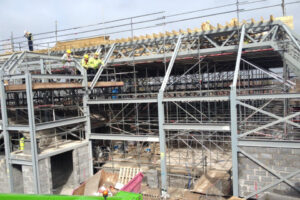 Construction and Infrastructure projects currently make up over 20% of the Government’s Major Projects. So, when we talk about delivering successful projects and programmes, 1 of the 4 capability areas set out in the Civil Service Reform plan, it’s important to acknowledge the ways in which the Government is working to improve construction.
Construction and Infrastructure projects currently make up over 20% of the Government’s Major Projects. So, when we talk about delivering successful projects and programmes, 1 of the 4 capability areas set out in the Civil Service Reform plan, it’s important to acknowledge the ways in which the Government is working to improve construction.
The Government Construction Strategy was published in 2011 with the aim of achieving savings of 15 to 20% by the end of the current Parliament.
While ultimately savings-driven, the strategy has allowed us to improve project and programme delivery across government construction.
Initiatives include:
- improving the procurement process
- fairer payment for contractors/suppliers
- improving supply chain integration
Cost benchmarking has been a significant factor in these improvements. We know government clients in construction procurement need appropriate ownership of project risk, and cost benchmarking data can help.
Construction projects can be considered distinct from transformation or ICT projects in the way they engage with Small and Medium Enterprises (SMEs), around 18% of which operate in the construction industry.
We recognise government construction projects can make or break small businesses and that 1 of the crucial elements contributing to their success is making sure that SME contractors are paid within a reasonable amount of time on completion of a job.
Project bank accounts and the Government Construction Fair Payment Charter are 2 ways in which the government is helping to ensure that SMEs working on construction projects are paid fairly.
Construction projects are generally more successful if everyone is collaborating towards a common goal from day 1. Improving supply chain integration and early contractor involvement is key to this success.
In part, this means ensuring that your contractors across the supply chain - plumbers, electricians and other specialists - have early sight of the building blueprints. This can save time and money, when work on the construction site is under way, and a reduction in the amount of ‘re-working’ needed at the end of the project.
An effective way of doing this is through Building Information Management (BIM), which we have mandated across government construction projects. If you believe BIM is just an IT system, you’ve missed the point. We see BIM as a catalyst for change, in terms of contractor collaboration, early involvement and as a way of making the construction industry more attractive to a wider cross-section of businesses. Digital should mean there is take-up from a wider pool because it means construction no longer being seen as dominated by trades involving manual labour.
Following on from this, we recognise that there is a skills gap across the construction industry. This was addressed by Vince Cable at the Government Construction Summit in July 2014, when he stated: “The construction industry has lost 350,000 people, many of them highly skilled. Many won’t come back, they have dropped out of the labour market.”
In order for it to invest in the skills we need for the future, we know that industry needs to have confidence that the government is investing in construction. Publishing The Government Construction Pipeline is 1 way we are helping to build this confidence.
The Government Construction Pipeline is about making data transparent and accessible throughout the supply chain and improving the way in which the construction industry can view what government is constructing, or planning to construct, up to 2020 and beyond. Published twice a year, it outlines the level of investment in construction projects confirmed, proposed or planned by central government. This allows the industry to see where projects are taking place, both in terms of region and sectors, and helps show that government is investing in construction.
Project delivery in government construction covers many diverse and exciting initiatives, each offering their own unique challenges and requiring a range of transferrable skills. You can read about how the Civil Service is improving capability across the spectrum of project delivery in David Blackall's blog.
Delivering successful projects and programmes is one of the 4 priority capability areas set out in the Civil Service Reform plan. If you are involved in project and programme delivery you should enrol in the Project Delivery Profession. If you want to know more about the work of the Government Construction team, please email governmentconstructionteam@cabinetoffice.gov.uk.

1 comment
Comment by Richard Saxon posted on
Please make two corrections:
Use of the term 'blueprints' is decades out of date, referring to a long defunct way of printing drawings. We don't even print them now. Say 'designs'.
BIM stands for Building Information Modelling, not Management.